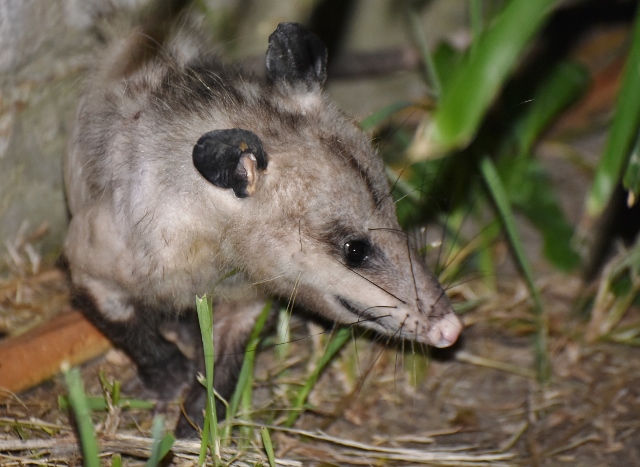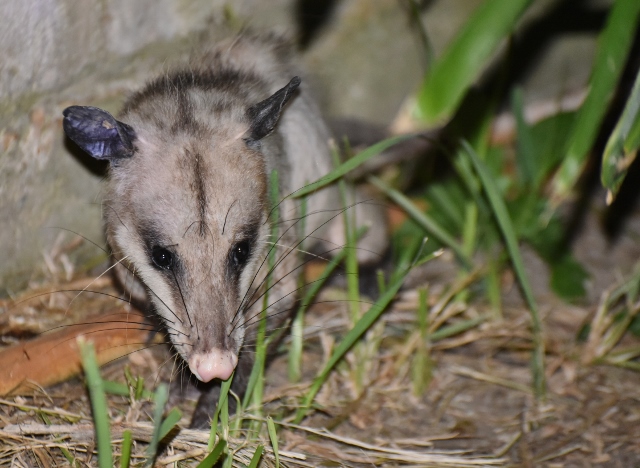
Story and photos by Anita Westervelt, Texas Master Naturalist
The Virginia opossum (Didelphis virginiana) is a critter of the night more beneficial to a garden and the urban scene than it is a menace or threat — and they’re just almost cute.
Opossums are relatively small — about the size of a cat — ranging from four to 15 pounds depending on habitat and food availability; they are smaller in the tropics and larger in urban areas. They have gray fur, a white face with a long, pink-nosed snout, black ears and legs and a very long, hairless tail.
In town, this wild creature is more apt to quietly steal left-out pet food, help rid a yard of disease-carrying ticks and clean up strewn garbage rather than the culprit knocking over garbage cans and creating a mess — a sport best left to dogs and raccoons.
Opossums are scavengers and omnivores — that’s a good thing — it means they aren’t picky eaters, opting for both meat and vegetation as well as adding roadkill to the mix.
They spend their nights nose to the ground, gently swaying their head back and forth as they locomote at a steady pace, sometimes covering as much as two miles of territory in search of food; they come out at dusk and remain active until dawn. Opossums have keen eyesight similar to that of a cat. Long, stiff hairs at the side of their snout help them navigate in the dark.
Away from urban habitats, opossums eat nuts, seeds, grass, fruit, vegetables, grains, snails, insects like grasshoppers, crickets and beetles and small animals such as mice, rats, birds and frogs.
Their most notable dietary option is ticks — they eat up to 95 percent of the ticks they encounter and an estimated 5,000 ticks per season helping to prevent the spread of tick-borne illnesses like Lyme disease and Rocky Mountain spotted fever, according to en.wikipedia.org. Another eating habit, devouring carrion, helps lower the risk of spreading disease — another reason to consider them an important friend to the environment.
Opossums have adapted well to urban living although typically their ideal habitat would be woodland and thickets preferably near a water source. After a busy night, opossums will nest in brush piles, hollow trees, drainage areas, buildings and abandoned burrows; they change denning sites often. They are good swimmers and agile climbers — able to use their prehensile (grasping) tail for stability as they walk along tree branches.
As wild animals go, opossums have another positive quality: they are not aggressive, although as a defense, they will open their mouth (displaying most of their 50 teeth) and hiss and look quite vicious, but it’s a bluff. Opossums have more teeth than any other land mammal on this continent. An extreme bluff is when the animal might flop down and play dead — a defense generally used by young opossums.
Opossums are solitary creatures and active breeders. They are the only marsupial animal native to North America — an animal that carries its young in a pouch.
– 30 –
Other resources helpful in writing this article were: humanesociety.org, animaldiversity.org, livescience.com and “Critters of Texas Pocket Guide” produced in cooperation with Wildlife Forever, Texas Wildlife Association and San Antonio Livestock Exposition, Inc.
SIDEBAR
Is it a possum or is it an opossum?

Compiled by Anita Westervelt, Texas Master Naturalist
- Opossums and possums are different animals. Opossums (Order Didelphimorphia) live in North America; possums live in Australia. Both are marsupials. Possums (order Diprotodontia) are more closely related to kangaroos. Grammarly.com
- The O in opossum is spelled but not pronounced. It is a silent letter. The articles “a” and “an” are correctly based on the first pronounced letter, not simply the first letter. En.wikipedia.org
- Both possum and opossum correctly refer to the Virginia opossum frequently seen in North America. In common use, possum is the usual term; in technical or scientific contexts opossum is preferred. Opossum can be pronounced with its first syllable either voiced or silent. Merriam-webster.com
- The opossum received its name in the early 1600s from Captain John Smith of the Jamestown colony in Virginia. The name is derived from aposoum, a Virginia Algonquian word meaning “white beast.” On the other hand, in the late 1700s, Sir Joseph Banks, a naturalist who accompanied Captain James Cook on his first great voyage, likened a furry creature he saw in Australia to “an animal of the Opossum tribe.” The term for the ringtail marsupial that he spotted was shortened to possum. Dictionary.com
- The spellings of these words are not interchangeable; opossums and possums are different animal groups in vastly different regions of the world. In North America, it is common to see possum written when the writer actually means opossum. Garner’s Modern American Usage states that possum is more than twice as common in print than is opossum and even more common in speech. Opossumpower.org
No matter how you pronounce it here in the Valley, most people will know what you’re talking about, and if you want to know more about this interesting critter, check out these fun and informative opossum articles by Carolyn Bierschwale in a publication by the Texas Wildlife Association:
https://www.texas-wildlife.org/images/uploads/Critter_Connections_June_2012.pdf
– 30 –
